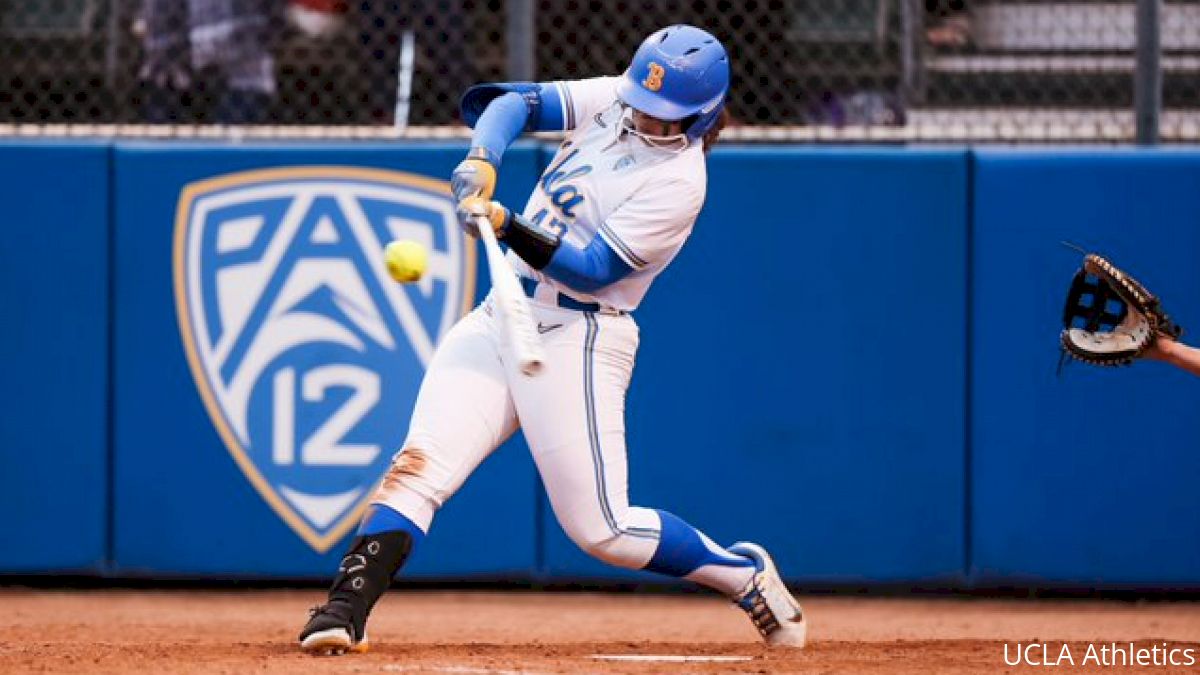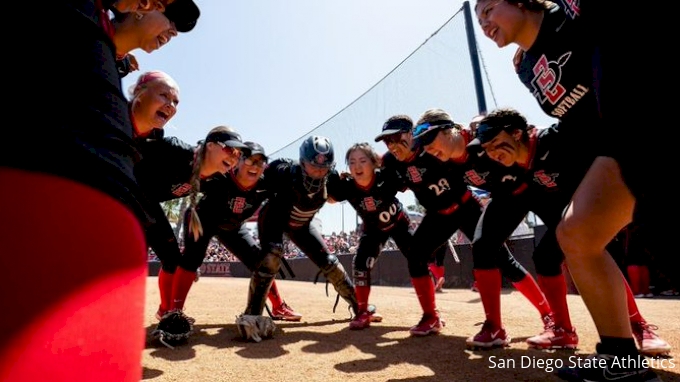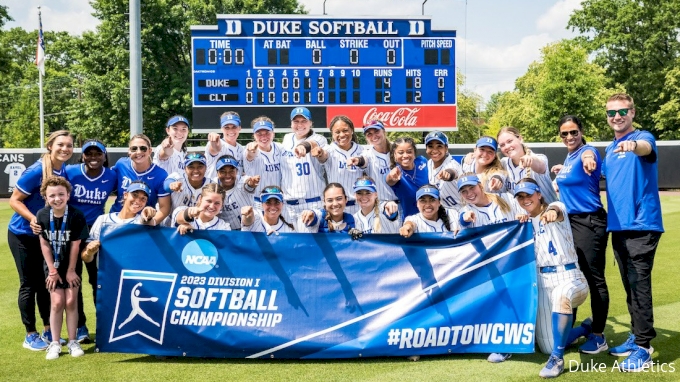Five Takeaways From The 2023 NCAA Softball Regional Round
Five Takeaways From The 2023 NCAA Softball Regional Round
Here are FloSoftball’s five takeaways from the wild weekend of play in the regional round of the 2023 NCAA Softball Tournament.

A golden rule in postseason play is to never assume that any game is a gimme.
A few elite-level programs found this lesson out the hard way in the regional round of this year’s NCAA Softball Tournament, though to be fair, some of the results that did happen were downright shocking.
But for many of the favorites to make a deep run, they did their jobs effectively and are still playing softball because of it.
For the second straight season, a No. 2 overall seed was knocked out of the field before the Super Regional round, and of the 16 national seeds that were named when the field was released earlier this month, 13 remain.
But a year after Texas became the first unseeded team in history to play for a national championship, any team that has taken such an opponent lightly since, didn’t properly listen.
For the 16 teams left standing, all that stands between them and playing in Hall of Fame Stadium in Oklahoma City is two more wins.
However, with the field set to get sliced in half before the WCWS, it means moments of greatness in high-pressure situations are going to be more vital than ever.
Welcome to the Super Regional round. But before we play ball, let’s examine how we got here in the first place.
Here are FloSoftball’s five takeaways from the wild weekend of play in the regional round of the 2023 NCAA Softball Tournament – just in time for the remaining teams suit up for the Super Regional round for a berth in the Women’s College World Series.
No. 2 UCLA Goes Down On Day 2
This is May.
In one of the most shocking occurrences ever seen from such a high-ranked team in the regional round, second-seeded UCLA – considered by many to be one of the few, if not the only, team in the country capable of dethroning mighty top-seeded Oklahoma – didn’t just fail to make it to Oklahoma City, it failed to make it out of its own regional.
Though then-No. 2 Florida State also didn’t make it to the Super Regional last year, the Seminoles at least made it to the regional final, before they dropped two straight games to a very good Mississippi State team.
The Bruins couldn’t even do that, as they didn’t win a game.
💙🐻💛#GoBruins pic.twitter.com/WnvXz1S38s
— UCLA Softball (@UCLASoftball) May 22, 2023
Western Athletic Conference champion Grand Canyon kicked things off Friday by stunning UCLA with a 3-2 win on All-American pitcher Megan Faraimo, with Madison Schaefer’s three-run home run in the fourth inning proving to be enough to allow the Lopes to skate by and hand a No. 2 seed its first loss in a regional opener since 2005.
The next day, staring down elimination against Liberty, the Flames got a seventh-inning go-ahead base hit from KC Machado and held on in the bottom half of the frame for a narrow 2-1 victory, sending the Bruins packing.
They missed the Supers for the first time in a decade and snapped a streak of seven consecutive WCWS appearances dating back to 2015.
A 52-win season for UCLA now ends with a whimper – and opens the door even wider for OU to be the first school to win three consecutive softball national titles since the Bruins did from 1988-1990.
Rest of Pac-12 Stands Out, Impresses
Ironically, UCLA’s quick elimination last week didn’t really impact the Pac-12 Conference’s reputation too much. In fact, the rest of the league did A-OK.
No conference has more teams in the Supers than the Pac-12’s four, with five of the six teams that got bids making it to at least the regional final.
The highest-seeded school among them is No. 7 Washington, which was toppled in its own regional last season by an unseeded Texas team that eventually went on to make it to the WCWS championship series.
Things got hairy for the Huskies again this season, as they dropped the first game of the regional final to McNeese State, setting up a loser-out finale that looked done and dusted when the Cowgirls surged to a 6-0 lead they held until the seventh inning.
The Comeback. pic.twitter.com/UxR2YYVMpv
— Washington Softball (@UWSoftball) May 22, 2023
Then UW pulled off a comeback for the ages. An almost beyond-belief seven-run seventh inning gave the Huskies the lead with their backs against the wall, and McNeese’s failure to score in the bottom half sent Washington to its 15th Super Regional in dramatic fashion.
Elsewhere, No. 15 Utah returned to the Supers after a six-year drought (not losing a game in the Salt Lake City Regional), No. 9 Stanford made it back-to-back Supers appearances, as it rolled through its regional and unseeded Oregon beat No. 11 Arkansas twice in Fayetteville to get out of a regional for the first time since 2018 – the last time the Ducks made the WCWS.
No. 1 Oklahoma Closer To History
As rivals around them slipped up in other regionals, the No. 1-ranked Sooners put on a show in Norman, winning a 13th straight regional crown, while hardly breaking a sweat along the way.
Now two wins away from breaking Arizona’s decades-long NCAA record for the most consecutive victories (47), OU made it to the Supers with ease and did it with style.
Coach Patty Gasso’s juggernaut opened play with back-to-back shutouts, run-rule blowouts over Hofstra and former Big 12 Conference rival Missouri, meeting California (which finished with 74 home runs, a top-15 rank nationally) in the final, needing to only win one game in two tries to capture the hardware.
𝐒𝐨𝐨𝐧𝐞𝐫 𝐒𝐢𝐱 🚀
— Oklahoma Softball (@OU_Softball) May 21, 2023
Tied an NCAA tourney record with 6 HR (done six times...three of which were the #Sooners)#ChampionshipMindset pic.twitter.com/q4xvbALHQA
The Sooners took that opportunity to toy with the Golden Bears, smashing four of its six home runs for the game in a six-run first inning, then had eight more runs by the middle of the third to get out to a commanding 14-0 lead.
Cal tried showing fight with a three-run bottom half, but after the Sooners got two more across in the fourth to close out the show with a 16-3, five-inning blowout. Any hopes the visitors were going to extend the game were dashed as OU did what it wanted, how it wanted.
No. 16 Clemson awaits in the Supers later in the week, and if the Sooners come out unscathed, both a seventh consecutive WCWS trip, plus the longest winning streak in Division I softball history will be in their possession.
Louisiana, SDSU Carry The Mid-Major Torch
After a 2022 tourney in which power-conference programs largely reigned supreme in the national postseason, two teams in particular – Louisiana and San Diego State – are representing their leagues on the biggest stage and each could have a legitimate chance to get to (and make noise in) Oklahoma City.
Let’s start by talking about the Aztecs first, the winners of the Los Angeles Regional and the team that rose up from the chaos of UCLA’s early exit.
Coached for the second season by longtime assistant, former Bruins legend and gold medal-winning Olympian Stacey Nuveman-Deniz, SDSU didn’t even have to see UCLA at Easton Stadium to get through to the Supers for the first time in its history.

Instead, it won the games it needed to with as little drama as possible, picking up shutout victories over Liberty and Grand Canyon, before taking down the Flames again in the final by a 6-3 scoreline, pushed forward by a pair of sixth-inning homers from AJ Murphy and Jeweliana Perez.
As for the Ragin’ Cajuns, the six-time WCWS qualifiers have long been one of the best mid-major programs in America, but UL had been amid a bit of a slump by its lofty standards, with no Supers trips since 2016.
That changed when the 50-win Cajuns – needing to win two against in-state rival and No. 10 LSU in Baton Rouge – did just that, eliminating the Tigers with 7-4 and 9-8 victories to put themselves two wins away from a seventh WCWS appearance, repping the Sun Belt Conference.
WCWS Could Feature Multiple First-Timers
All eight WCWS qualifiers in 2022 had previously made it to that round in previous seasons.
As many as three new teams could qualify at once to the 2023 WCWS, and two – Atlantic Coast Conference rivals, Clemson and Duke – are seeded.
A major reason behind both the Tigers and the Blue Devils having not made it to the WCWS before is because they are very new programs, with Duke only starting play in 2018 and Clemson in 2020.
As Clemson, which won its own regional after beating Auburn in the final, is stuck with the momentous task of beating top-ranked Oklahoma twice at home in order to get to Oklahoma City, eighth-seeded Duke is the more likely of the duo to get to the WCWS after its second straight regional win, though the Blue Devils will need to get past a well-established No. 9 Stanford squad (itself a two-time WCWS qualifier) to do it.

Meanwhile, Clemson undoubtedly will be the underdog against OU, but will have at least a fighting chance, as the Tigers do have one of the best players in the country in Valerie Cagle (.467 average, 19 home runs, 57 RBIs), a two-way superstar (25-6, 1.20 ERA, 186 strikeouts in 186 innings as a pitcher) who was named the ACC Player of the Year earlier this month.
And then, as mentioned above, there’s San Diego State, which arguably could be favored to beat No. 15 Utah twice and represent the Mountain West Conference on the biggest stage after making it out of a regional many penciled in for UCLA.
Whatever happens, keep tabs on how all three of the teams play when making history is on the line.